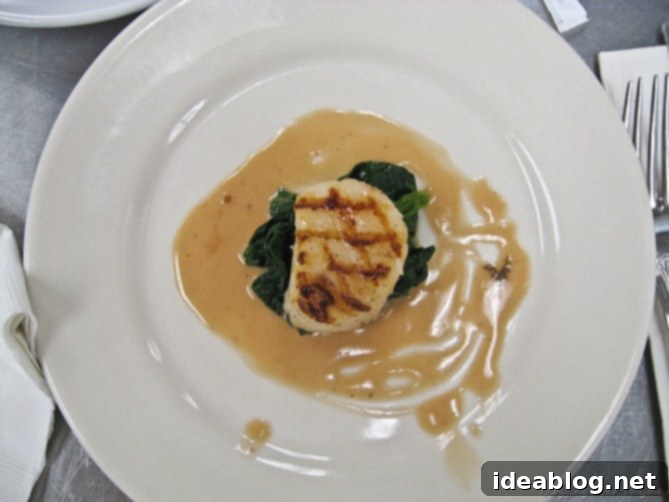Behind the Culinary Curtain: Mastering Classic Techniques with Petits Fours, Seared Chicken, and Scallops
Apologies for the unexpected delay in my weekly culinary update! Life in the kitchen can be incredibly demanding, but I’m thrilled to be back, ready to share all the intricate details from last Thursday’s intensive cooking session. It was an exceptionally packed day, overflowing with a diverse array of new dishes and techniques, making it one of the most hectic yet rewarding experiences in the kitchen thus far. Thankfully, our team demonstrated excellent time management and coordination, allowing us to navigate the demanding schedule with relative ease. A particular highlight was the opportunity to collaborate with Tasha again; her enthusiasm and skill make every task more enjoyable.
I’ll begin with the day’s dessert, which, despite its deceptive simplicity, was a delightful introduction to another classic petits fours sec. We embarked on crafting elegant PALMIER cookies, affectionately known as “elephant ears” or “butterfly cookies.” These crisp, sugary pastries are traditionally a clever way to utilize leftover puff pastry trimmings, minimizing waste while creating a delicious treat. Our process commenced with rolling out the delicate puff pastry to an even thickness, then generously sprinkling both sides with a finely balanced mixture of granulated sugar and ground cinnamon. This simple coating is crucial, as the sugar caramelizes during baking, imparting that signature crisp texture and golden-brown hue, while the cinnamon adds a warm, aromatic depth.
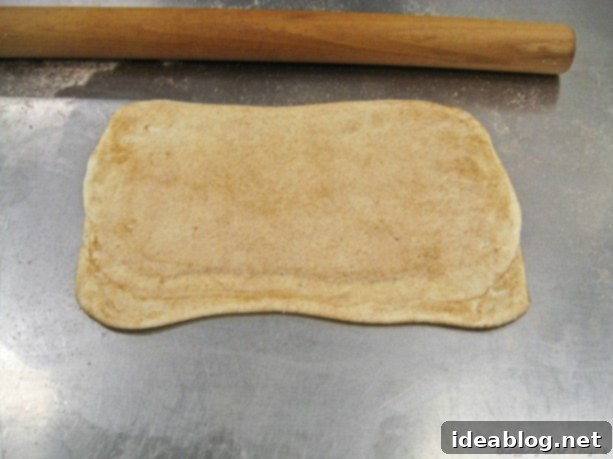
The next step involved carefully rolling the pastry from both ends towards the center, creating a distinct double-scroll shape. Precision here is key to achieving uniformly sized spirals. Once rolled, the pastry log was chilled briefly to firm up, making it easier to slice. We then cut the log into precise 1/2-inch widths, revealing the beautiful, symmetrical butterfly-like patterns. These delicate shapes were then arranged on baking sheets and baked in a hot oven for approximately 20 minutes. A critical step during baking involved flipping the cookies halfway through, ensuring even caramelization and crispness on both sides. The aroma filling the kitchen as they baked was absolutely divine, a perfect blend of sweet sugar and fragrant cinnamon.
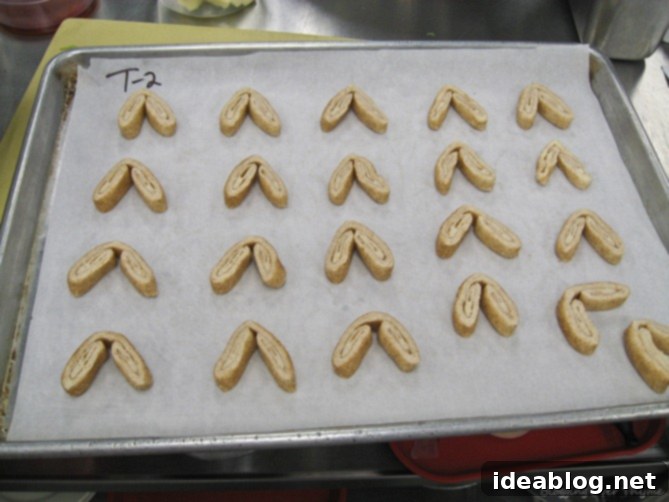
Upon emerging from the oven, golden and exquisitely flaky, our Palmier cookies were ready to be served. To elevate this simple pastry, we paired it with a luxurious sabayon. This exquisite dessert sauce is essentially a light, airy wine custard, renowned for its delicate flavor and velvety texture. The creation of sabayon is a true test of patience and technique: egg yolks, sugar, and in our case, a carefully selected sherry wine, are whisked continuously over a gentle bain-marie. The indirect heat is vital to prevent the eggs from scrambling, allowing them to gradually thicken and emulsify into a rich, frothy consistency. Once the sabayon reached its desired thickness, a very small quantity of freshly hand-whipped cream was delicately folded in, adding an extra layer of lightness and indulgence without compromising its structure.
This luscious sabayon was then spooned generously over a medley of fresh, vibrant fruit, providing a wonderful contrast in flavor and texture. For a final flourish, the sabayon topping was lightly torched, creating a beautiful caramelized crust that added another dimension of sweetness and a hint of smoky flavor. While undeniably delicious, this dessert was quite rich, offering a truly decadent experience. The interplay of the crisp Palmier, the creamy sabayon, and the fresh fruit made for a memorable ending to our culinary session.
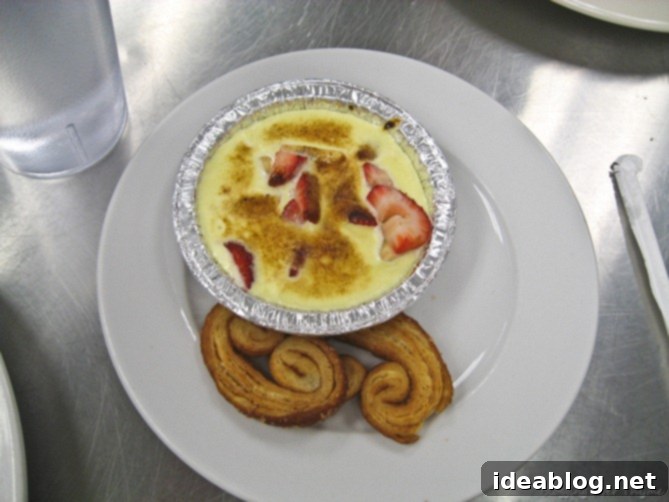
Transitioning to our savory preparations, the main course featured perfectly seared chicken, elegantly presented with a rich and savory mushroom Madeira sauce. This dish began with the fundamental skill of breaking down whole chickens, a crucial technique in professional kitchens. From each chicken, we carefully removed the breast, ensuring the first wing bone remained attached. This particular cut is known as an airline breast, a term coined because it was traditionally served on airplanes, offering a refined presentation while making the portion easier to handle and ensuring the meat cooks more evenly due to the bone’s presence, which also infuses additional flavor during cooking.
The remaining chicken legs and thighs were reserved for future use, demonstrating the importance of utilizing every part of the ingredient. Meanwhile, the spine and back of the chicken were meticulously chopped into very small pieces. These bones were then seared vigorously over high heat in a pan until deeply caramelized, building a foundational layer of flavor. Once seared, they were temporarily removed, and the pan was deglazed with a classic mirepoix (a aromatic medley of diced carrots, celery, and onions) and, notably, Madeira wine. This step immediately began the development of our rich sauce base, echoing a recurring theme of using fortified wines in our French culinary curriculum (a practice we’ve encountered before, emphasizing its versatility in classic French cuisine).
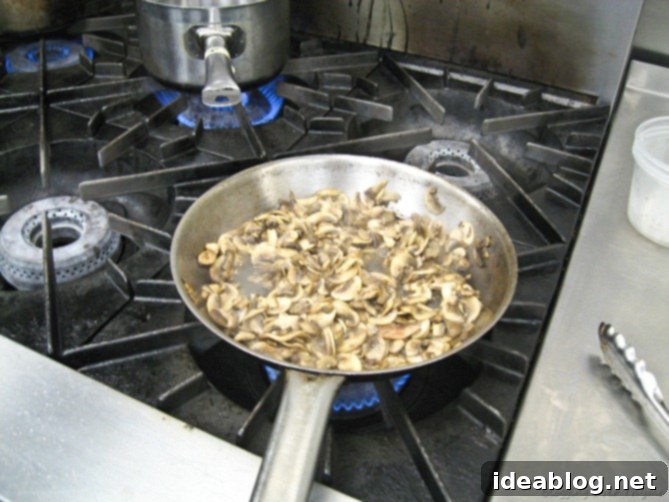
At this critical juncture, we introduced a highly reduced veal stock into the pan, returning the seared chicken bones to simmer gently. This entire mixture was then transferred to the oven, allowing it to slowly reduce further and intensify its flavors, creating the deeply savory and complex mushroom Madeira sauce. This patient process of reduction and slow cooking is paramount to achieving a truly professional sauce.
The airline chicken breast itself was cooked to order, a technique that presented its own set of challenges. Achieving perfectly cooked chicken breast requires a specific method to ensure all parts, from the thicker sections to the thinner edges, are cooked evenly without any part becoming dry or overdone. This involves constant attention and skillful maneuvering of the pan, strategically maximizing heat exposure on the thickest portions of the breast and carefully adjusting for thinner areas. The goal is a beautifully golden-brown crust and a succulent, juicy interior.
This particular dish, the seared chicken with its accompanying sauce, is slated to be on our second practical exam. The gravity of this assessment makes me incredibly nervous, fueling my determination to practice this dish extensively at home. I aim to master every nuance of the searing and sauce-making process to ensure perfection on exam day. While our attempts in class turned out quite well, I felt ours was slightly overcooked, highlighting the narrow margin for error in professional cooking and the need for rigorous practice.
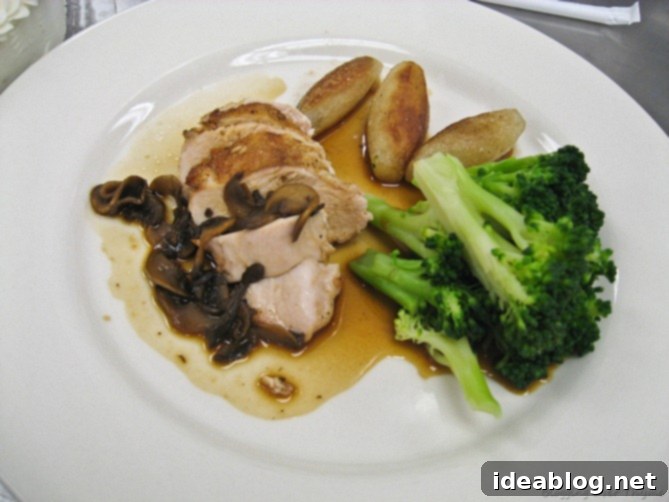
Our seared chicken was accompanied by classic POMMES RISSOLEES, showcasing the incredible variety within potato dishes in French cuisine! These are beautifully tourneed potatoes, meaning they are cut into precise, barrel-like shapes, ensuring even cooking and an elegant presentation. The process began with lightly blanching the tourneed potatoes, which partially cooks them and helps create a tender interior. Following blanching, they were meticulously sautéed in clarified butter, allowing them to brown evenly on all sides, developing a crisp, golden exterior and a creamy, flavorful inside.
Additionally, we served a side of plain steamed broccoli. It’s always refreshing and a welcome sight to see fresh, green vegetables accompanying a rich meal, especially when they aren’t drenched in butter. This simple addition provided a delightful textural and nutritional contrast to the main components of the plate.
Scallops also made their inaugural appearance on our menu that day, introducing us to the delicate art of cooking seafood. In class, we delved into the crucial distinction between dry-packed vs. wet-packed scallops. This knowledge is fundamental for any aspiring chef. Dry-packed scallops are the superior and, consequently, more expensive product. They are harvested and immediately frozen or shipped without any additives, meaning they are genuinely “dry” and retain their natural flavor and texture. In contrast, wet-packed scallops are typically stored in a solution of water and sodium tripolyphosphate (STP), a preservative that causes them to absorb water, increasing their weight and making them appear whiter. While more economical, this added water content impacts their cooking properties significantly, often leading to a rubbery texture and difficulty in achieving a proper sear. Wet-packed scallops are generally better suited for applications like mousses where their texture can be masked.
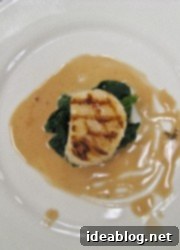
For our preparation, dry-packed scallops were unequivocally preferred. Their lack of excess moisture means they are far less likely to stick to the pan or “boil” in their own liquid when cooked over high heat. This allows for a beautiful caramelization, forming a desirable crust without becoming mushy. We grilled our scallops, rotating them precisely 90 degrees halfway through cooking on each side to achieve those coveted, classic crosshatch grill marks, indicative of expert technique. These perfectly seared scallops were then delicately plated with a vibrant bed of sautéed spinach and generously drizzled with a classic beurre blanc sauce.
While there are countless variations of beurre blanc, we focused on mastering the foundational, classic method. This elegant emulsified butter sauce begins with a flavorful reduction. Red wine vinegar, finely diced shallots, white wine, garlic, fresh thyme, black peppercorns, parsley stems, and a bay leaf are combined and cooked au sec – meaning until the liquid is almost completely evaporated. This intense reduction concentrates the flavors, forming the aromatic base for the sauce. At this precise point, a very small amount of heavy cream is introduced, which helps to stabilize the emulsion. The key to a perfect beurre blanc then lies in slowly whisking in cold, cubed butter, piece by piece, off the heat. The cold butter slowly melts into the warm reduction, creating a creamy, lustrous emulsification. The entire mixture is then strained through a fine-mesh sieve, ensuring a silky-smooth, refined sauce, free of any solids.
While I appreciated the technical artistry involved in creating beurre blanc, personally, I wasn’t its biggest fan. Its richness, coupled with the specific flavor profile of the reduction, was interesting but perhaps not to my immediate taste. However, I remain very curious to explore more modern interpretations or variations that might offer a different balance of flavors.
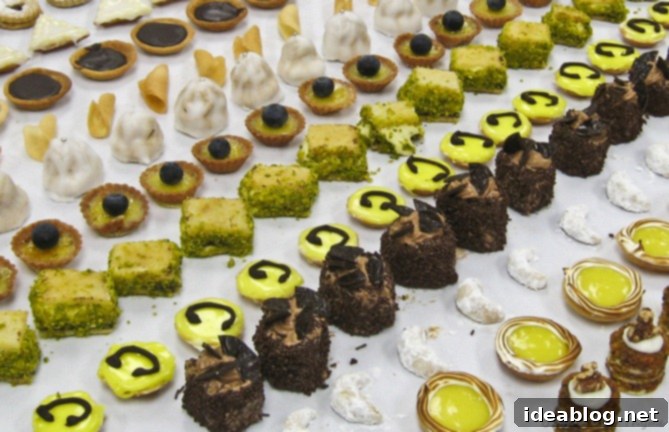
Our afternoon session shifted focus to pastry, specifically the intricate art of making CORNETS. These are small, delicate parchment paper cones, indispensable tools used for very finely piping chocolate or other decorative elements in patisserie. Crafting these perfectly conical tools is surprisingly more challenging than it sounds, requiring precision and a deft hand to achieve the ideal shape and stability for intricate work. We spent a good amount of time practicing this essential skill, understanding its importance for detailed garnishes. Following this, we were treated to a truly inspiring trip to the Phase II pastry classroom, where we witnessed a simply breathtaking and incredibly impressive PETITS FOURS buffet!
The sheer scale of this display was astounding. The Phase II students had dedicated the past three days to the meticulous production of this vast array of miniature confections. That very morning, they had spent hours painstakingly arranging each petit four, using rulers to ensure every piece was perfectly aligned and spaced – a testament to the discipline and aesthetic standards demanded in professional pastry. Each student was responsible for contributing several different varieties, showcasing their diverse skills. To name just a few of the exquisite offerings, there were delicate baklava, tangy lemon tarts, moist pound cakes, intricately layered mini carrot cakes, and beautifully handmade chocolate shells filled with rich coffee creams.
The selection was almost overwhelmingly abundant, offering so much to choose from that trying just one of everything felt like an impossible task! The precision, variety, and evident dedication poured into each tiny creation were truly inspiring.
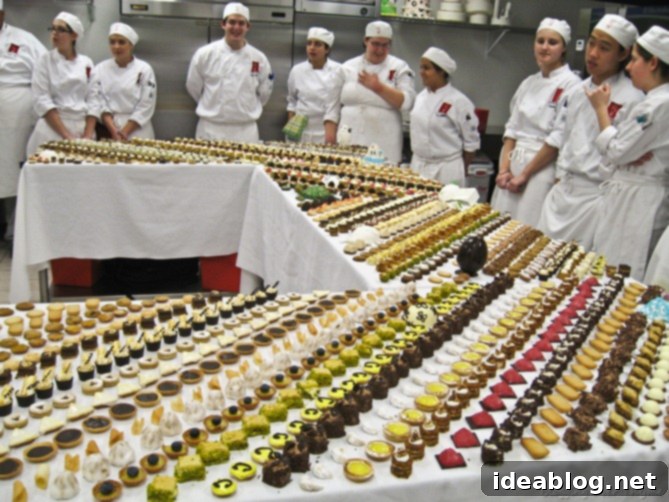
Amongst the dazzling array, there were these exceptionally special and unique candied fruits (pictured below). Our instructors explained that these fruits had been carefully dipped in a sugar syrup heated to a very specific temperature stage – which I’m quite sure was the “hard crack” stage. This precise temperature control is what gives them their distinctive characteristic: they become coated in an incredibly hard, glossy shell that shatters with a satisfying crispness when bitten into, yet remains completely free of any gumminess or stickiness. While this method has a specific, traditional name, I’m afraid it has unfortunately slipped my mind at the moment!
The candied fruits were truly fascinating and unlike anything I had ever tasted before. I particularly adored the candied orange segments. The natural tartness and citrusy brightness of the orange provided a perfect counterpoint, beautifully cutting through the intense sweetness of the hard sugar shell, creating a balanced and incredibly enjoyable sensory experience.
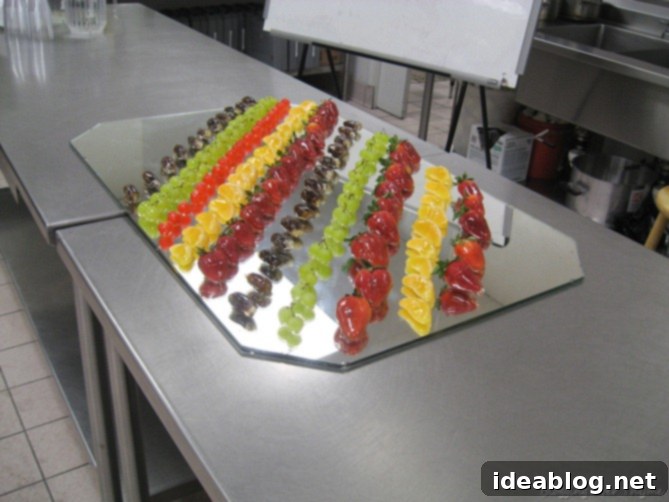
With another challenging and enlightening week behind me, there’s still a significant amount to accomplish before Monday’s class. This includes diving into my second major paper, which is due at the end of this week, further blending the theoretical with the practical aspects of our culinary education.
I hope everyone enjoys a relaxing and wonderful remainder of their weekend!
